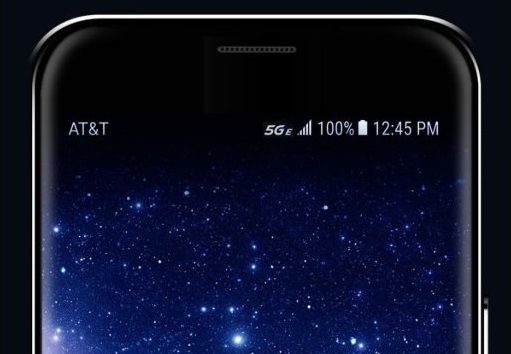
When is 4G not 4G? When it’s 5G, of course.
AT&T is rebranding potentially millions of 4G LTE smartphones to make it appear as though they are on 5G networks — explaining that many technologies deeply linked to the faster 5G networks all mobile carriers are beginning to roll out have already been introduced on the company’s existing 4G network. Phones “using” the 5G E network include the Samsung Galaxy A8 Active, LG V30, and LG V40. AT&T has even brought Apple on board: iPhones that are on AT&T and updated to iOS 12.1.2 will get the new 5G E logo when they are connected to AT&T’s so-called 5G Evolution network. So far, the logo is only showing up in the iOS 12.1.2 beta, but it will likely roll out as part of the iOS 12.1.2 update when it’s ready for consumers.
Sprint, in particular, has taken issue with the branding. A few weeks after announcing that it was suing AT&T, it has taken a full-page ad out in The New York Times, calling AT&T out and labeling AT&T’s 5G E as “fake 5G.”
“While Sprint is working hard to deliver mobile 5G and the first 5G smartphone in the U.S., AT&T is hard at work trying to convince you that they already won the race to 5G with something they call ‘5G Evolution.’ That is simply untrue,” reads the letter. “Don’t be fooled. 5G Evolution isn’t new or true 5G. It is fake 5G.
“They would love for you to believe they are different … better. The truth is AT&T is simply offering customers a nationwide 4G LTE network just like Sprint and all the other major wireless carriers. It’s not 5G.”
In early February, Sprint said it was suing AT&T, arguing that this implementation of fake 5G will damage Sprint’s efforts to release and promote true 5G. As part of its claim, Sprint is using a survey that asked consumers whether they believed “5G E” was as good as 5G, and whether they thought an AT&T phone bought today would be 5G capable. Fifty-four percent of responses believed 5G E was at least as good as 5G, while 43 percent believed AT&T phones bought today would be 5G capable — which simply isn’t the case.
Sprint argues that this move by AT&T will damage 5G’s reputation before real 5G gets out of the gate; similar moves to rebrand enhanced 3G services as “4G” in 2012 faced legal challenges as well. We’ll have to wait and see whether Sprint’s efforts fare any better than previous attempts.
“AT&T is deliberately deceiving consumers into believing that their existing 4G LTE network operates on a coveted and highly anticipated 5G network. The reality is that this network isn’t ‘new’ and ‘5G E’ is a false and misleading term,” a Sprint spokesperson told Digital Trends. “AT&T is just like Sprint and all the other major wireless carriers currently operating a nationwide 4G LTE network. AT&T’s deceptive ads have harmed consumers by persuading them to purchase or continue purchasing AT&T’s services based on the lie that they are offering 5G.”
This hasn’t been the only backlash against the move from AT&T, and many more argue AT&T’s move misleads users they’re using the latest and greatest tech when really they’re not. When asked about this, Igal Elbaz, AT&T senior vice president for wireless technology, defended its practices, arguing that, “What we’re trying to do is let [customers] know that there is an enhanced experience in their market.”
“We’ve been talking about 5G Evolution for a while now,” Elbaz said in an interview with Tom’s Guide. “We were pretty public about what we were doing and what we were deploying. All of our investment in the infrastructure and hardware is all 5G ready, so the moment the 5G software and the 5G devices show up, it’s a software upgrade to our network to enable our customers to move to 5G.”
5G networks promise blazing speeds and nearly nonexistent latency, leading to not just faster download speeds but improvements to a wide range of applications outside of simply mobile phones. Carriers are actively introducing “fixed wireless” options to let consumers use mobile networks in their houses, for example, providing a much-needed alternative to cable and DSL. The networks could also have applications ranging from self-driving cars to virtual reality to smart homes — if some serious technology hurdles can be avoided.
Meanwhile, 4G LTE, short for Long-Term Evolution, continues to … well, evolve. Gigabit LTE is an ongoing effort to improve the existing 4G networks, as a way to bridge 4G and 5G. It offers some of the benefits of 5G and relies on advanced technologies to get there, things like carrier aggregation, which uses multiple frequencies on cell towers to send data to and from your phone; 256-QAM, which allows more data to be transferred at one time; and 4×4 MIMO, which adds additional antennas to devices, allowing your phone to better pick up signals, thus resulting in increased speeds.
AT&T’s real 5G network is only available in 12 cities across the U.S.: Atlanta, Dallas, Houston, Indianapolis, New Orleans, Oklahoma City; Louisville, Kentucky; Jacksonville, Florida; Raleigh and Charlotte, North Carolina; and San Antonio and Waco, Texas. Service is initially limited to preselected customers and will be provided for free for at least 90 days.
Updated on March 12, 2019: Sprint has taken a full-page ad calling out AT&T’s 5G E.
Editors' Recommendations
- Visible’s affordable 5G plans just got even cheaper
- Does the Moto G Power have NFC?
- Does the Moto G Stylus have NFC?
- Motorola’s two new budget phones shouldn’t look this good
- Have T-Mobile? Your 5G service is about to get much faster


